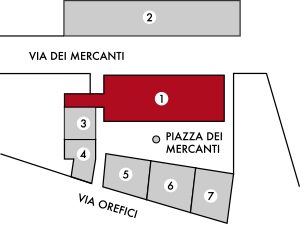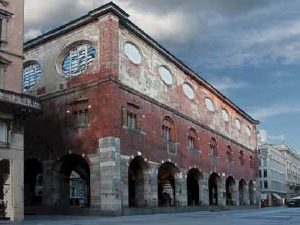Situato nel centro dell’antica Piazza dei Mercanti era il Broletto.
 Il Consiglio generale del Comune, presieduto dal podestà Aliprando Faba, ne avviò la costruzione nel 1228, stabilendo in quest’area, che non era ancora una piazza ma un insieme di vie, case e terreni, il nuovo centro del potere politico cittadino. Ma fu Oldrado da Tresseno nel 1233 che, come podestà di Milano, ne terminò la costruzione. Cittadino di Lodi, si dimostrò difensore della fede cattolica contro gli eretici. È lui a cavallo nel bassorilievo posto sul lato meridionale del Palazzo sopra l’iscrizione che ne ricorda i meriti soprattutto nella lotta contro i Catari. Recuperata tra i lacerti di antichi marmi, la scrofa semilanuta, antica insegna cittadina, compare in bella vista su un pilastro del lato opposto. L’edificio era a due piani. In basso, un ampio porticato sotto il quale notai e banchieri svolgevano le loro
Il Consiglio generale del Comune, presieduto dal podestà Aliprando Faba, ne avviò la costruzione nel 1228, stabilendo in quest’area, che non era ancora una piazza ma un insieme di vie, case e terreni, il nuovo centro del potere politico cittadino. Ma fu Oldrado da Tresseno nel 1233 che, come podestà di Milano, ne terminò la costruzione. Cittadino di Lodi, si dimostrò difensore della fede cattolica contro gli eretici. È lui a cavallo nel bassorilievo posto sul lato meridionale del Palazzo sopra l’iscrizione che ne ricorda i meriti soprattutto nella lotta contro i Catari. Recuperata tra i lacerti di antichi marmi, la scrofa semilanuta, antica insegna cittadina, compare in bella vista su un pilastro del lato opposto. L’edificio era a due piani. In basso, un ampio porticato sotto il quale notai e banchieri svolgevano le loro  attività. Sopra, una grande sala realizzata per ospitare le riunioni del Consiglio comunale che fra XIII e XIV secolo si attestò sui Novecento membri, scelti in rappresentanza delle sei porte della città. La sala era utilizzata anche come aula di giustizia. Il palazzo continuò a ospitare gli uffici municipali anche dopo la nascita del Ducato di Milano nel 1395, con l’investitura imperiale di Gian Galeazzo Visconti a principe e duca: da quel momento si trovò però al centro di una piazza sempre meno caratterizzata in senso politico e più in quello commerciale per la presenza della sede della corporazione dei mercanti, vicini al potere visconteo. A metà del XVI secolo il palazzo venne suddiviso in verticale, ospitando al primo piano la Corte di Giustizia e nel sottotetto l’Archivio comunale e poi quello notarile. L’edificio subì nuovi interventi nel XVIII secolo, sotto il governo austriaco: fu rialzato per aumentarne la capienza con l’aggiunta di ampi finestroni ovali ancora oggi visibili. Anche la storia dei portici si evolve nel tempo: nella prima metà del 1700 ne termina l’uso antico di farvi il mercato e poi, a fasi alterne, vengono chiusi e riaperti per farne spazi commerciali. Sembra esserci stato a fine ‘800 un negozio della ditta di biciclette Edoardo Bianchi e dal 1944 il negozio della Rinascente per ben sette anni fino al ripristino della sede bombardata di Piazza Duomo. Nel 1953 le prime sette targhe con i nomi dei Partigiani caduti in guerra trovarono collocazione sotto il Portico riaperto.
attività. Sopra, una grande sala realizzata per ospitare le riunioni del Consiglio comunale che fra XIII e XIV secolo si attestò sui Novecento membri, scelti in rappresentanza delle sei porte della città. La sala era utilizzata anche come aula di giustizia. Il palazzo continuò a ospitare gli uffici municipali anche dopo la nascita del Ducato di Milano nel 1395, con l’investitura imperiale di Gian Galeazzo Visconti a principe e duca: da quel momento si trovò però al centro di una piazza sempre meno caratterizzata in senso politico e più in quello commerciale per la presenza della sede della corporazione dei mercanti, vicini al potere visconteo. A metà del XVI secolo il palazzo venne suddiviso in verticale, ospitando al primo piano la Corte di Giustizia e nel sottotetto l’Archivio comunale e poi quello notarile. L’edificio subì nuovi interventi nel XVIII secolo, sotto il governo austriaco: fu rialzato per aumentarne la capienza con l’aggiunta di ampi finestroni ovali ancora oggi visibili. Anche la storia dei portici si evolve nel tempo: nella prima metà del 1700 ne termina l’uso antico di farvi il mercato e poi, a fasi alterne, vengono chiusi e riaperti per farne spazi commerciali. Sembra esserci stato a fine ‘800 un negozio della ditta di biciclette Edoardo Bianchi e dal 1944 il negozio della Rinascente per ben sette anni fino al ripristino della sede bombardata di Piazza Duomo. Nel 1953 le prime sette targhe con i nomi dei Partigiani caduti in guerra trovarono collocazione sotto il Portico riaperto.
The Broletto (town hall) was located in the centre of the old Piazza dei 
Mercanti. Headed by the podestà Aliprando Faba, the city council started to build it 1228, thus establishing in this area — which was not yet a square, but a network of streets, houses and plots of land — Milan’s new centre of political power. However, it was only completed in 1233 by the new podestà, Oldrado da Tresseno. Originally from Lodi, he was a defender of the Catholic faith against heretics. He is portrayed on horseback in the bas-relief on the south side of the palazzo above the inscription recalling his virtues, especially in the fight against the Cathars. A reused antique marble, the scrofa semilanuta (half-woolly sow), the city’s ancient emblem, is affixed to a pillar on the opposite side. The building had two storeys. At ground level there was a spacious loggia where notaries and bankers carried out their business. Above this there was a large hall housing the meetings of the city council, which, in the thirteenth and fourteenth centuries, comprised around nine hundred members, who were chosen as representatives of the districts corresponding to the city’s six gates. The hall also served as a courtroom. The building continued to house the municipal offices after the founding of the Duchy of Milan in 1395, with the imperial investiture of Gian Galeazzo Visconti as prince and duke. From then on, however, it was in the centre of a square that, while losing its role as the hub of the city’s political life, became increasingly important as the heart of its commercial activity, with the presence of the headquarters of the merchants’ guild, which was closely linked to the power of the Visconti. In the mid-sixteenth century the palazzo was subdivided in a vertical sense, so that the law court was located on the first floor, while the attic housed the municipal archives and then the notarial ones. Further changes were made in the eighteenth century, under Austrian rule: its height was raised in order to increase its capacity, with the addition of the large oval windows that are still visible today. The ground-floor loggia also evolved in the course of time: in the first half of the eighteenth century it ceased to function as a market and then, on various occasions, it was closed and opened to create commercial spaces. Until the end of the nineteenth century it appears there was a shop of the Edoardo Bianchi cycle firm and, from 1944, the Rinascente had a shop here for seven years until its Piazza Duomo store, which had been bombed, was rebuilt. In 1953 the first seven plaques with the names of partisans killed in the war were placed in the loggia, now once again open.